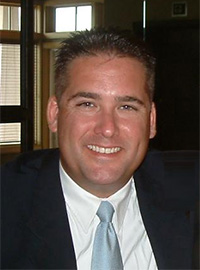
Ovations in airports are nice. Tears, cheers and anthems at ballgames and parades? Swell.
But emotional gestures to military veterans and active-duty warfighters frequently have the air of co-opting another’s sacrifice for the pleasure of feeling patriotic. What many veterans would appreciate more than all the medals and gratitude is something only the bottom-line world of business can provide: a job offer.
"There is absolutely no shortage of goodwill out there," says veteran Ted Wadsworth, senior director of veteran programs for Monster Government Solutions, operator of the Military.com website that receives 6.5 million unique visitors a month. Translating goodwill to good pay and rewarding careers is a thorny problem that a bevy of government, corporate and not-for-profit programs are working to solve. In many cases they’re succeeding. (See the bottom of this story for a clickable chart of veteran employment initiatives from every US state government.)
Among the job board programs Wadsworth oversees is USTechVets.org, a collaborative effort of the Consumer Electronics Association (CEA), Northern Virginia Technology Council (NVTC), Monster.com and Military.com focused on reducing veteran unemployment and giving technology industry companies access to American’s veteran workforce. It is the centerpiece of Monster’s Tech Vets Network. Wadsworth says the number of active veteran resumes on this subset of Monster.com military resumes has reached 972,000 and is rapidly approaching 1 million.
"I defy anybody to show me a bigger database," he says.
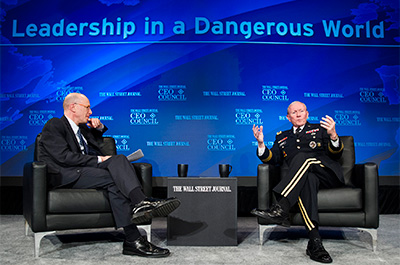
Or a deeper one. The key is the network effect, says Wadsworth, as documents are shared across multiple sites, and vets and employers alike can access through multiple portals using one log-in. He took a quick look about a year ago to assess skill areas, and found among the 840,000 TechVets resumes then in circulation a particular strength in cybersecurity. "Those with computer skills were in the hundreds of thousands, and were still in the tens of thousands with specific cybersecurity skills."
Monster releases an annual Veterans Talent Index. This year’s, released in May, found that majority of respondents seek employment at companies that market themselves as veteran friendly (85 percent) and have veterans that work there (80 percent). "Yet 68 percent of employers surveyed do not have veteran-specific retention programs in place," said Monster. "Employer respondents noted the most common and effective retention programs for veteran employees are those that emphasize mentoring, career paths, and communication.
"Many surveyed employers (69 percent, the highest response rate in three years) say their company has a stated commitment to hiring veterans," said the report, "and 67 percent report that hiring veterans is ‘a strategic initiative in recruiting company talent,’ although 89 percent of surveyed employers agree that they hire the best talent regardless of veteran status. More than half of the employers surveyed do not have major concerns when hiring veterans. Of those who do, their foremost concerns are veteran employees fitting into corporate culture (28 percent) and transferring military skills to corporate job skills (27 percent).
The US military veteran population numbers more than 21 million today, according to the US Bureau of Labor Statistics, including just over 3 million who have served since September 2001.
Wadsworth, who suffers from vertebrae and surgery-caused vocal cord injury from a training fall off a tank, says the dynamics of job boards sometimes run counter to what you learned in economics class.
"In the economy, the more choices the consumer has, normally the better for the consumer," he says. "But in the job board world, it’s actually not good. The more opportunities or choices the job seeker has, the more fragmented all the jobs are — one site might have jobs from these employers, another site might have them from another set. It’s the same from the employer side – a site may have a fraction of the veterans out there. It’s counter-intuitive. There are so many resources out there, but the jobs are fragmented."

Some work is helping attach the fragments. In April the National Association of State Workforce Agencies (NASWA), DirectEmployers Association (DirectEmployers), and the U.S. Chamber of Commerce Foundation’s (USCCF), Hiring our Heroes program (HOH), signed an agreement committing themselves to partner with each other and leverage the strengths and expertise of all three organizations.
"Through this innovative partnership, we will be able to better guide our military men and women toward the more than 1 million available jobs in the National Labor Exchange," said Eric Eversole, executive director of Hiring Our Heroes and vice president at the US Chamber. "This is public and private sector collaboration at its best and will help veterans and service members make more informed decisions about career opportunities, and to do so earlier in the transition process."
The partnership will initially seek to use the existing public-private partnership between NASWA and DirectEmployers, known as the National Labor Exchange (NLX). In 2013, the NLX included close to 9 million individual jobs from approximately 340,000 employers of all sizes.
One organization with a military hiring program worth modeling, says Wadsworth, is The MITRE Corp., a not-for-profit based in McLean, Va., that operates R&D centers sponsored by the federal government. In October MITRE was selected by the US Commerce Dept.’s National Institute of Standards and Technology (NIST) to operate, in partnership with the University System of Maryland, the first federally funded R&D center solely dedicated to enhancing cybersecurity and protecting national information systems, located in Rockville, Md. MITRE will staff the center, part of the National Cybersecurity Center of Excellence, with 40 information security professionals.
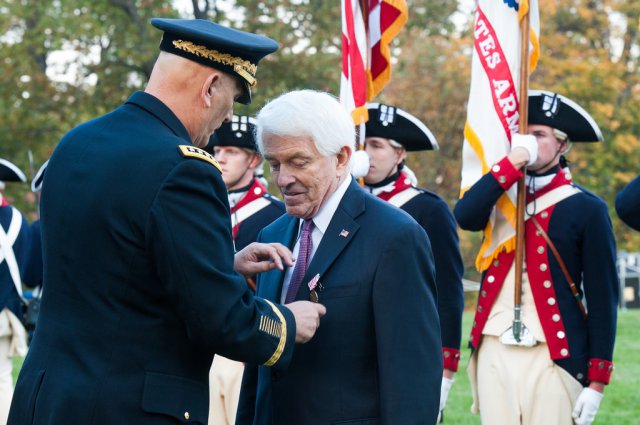
"They have a commitment to veterans that is incredible," says Wadsworth, including a mentorship program that helps veterans through what even the most prepared can find to be a rocky transition period.
"I retired as a lieutenant colonel, and did recruiting, so I really prepared for my transition, because I knew it was coming," he says. "But it was the most difficult thing I’ve ever done. The biggest reason was just understanding what everybody was talking about — corporate English is a lot different than military English."
For these reasons and more, the attrition rate for hired veterans is substantial, says Wadsworth. But proactive efforts can reduce that risk.
"What MITRE has done is education, to help bring them up to speed on corporate life," he says.
Models Worth Following
Programs run by corporations or state governments range from simple information clearinghouses to more proactive efforts, including special incentives, educational benefits (such as Alabama’s renowned G.I. Dependents’ Scholarship program) or programs targeting jobs within the government itself. Here are a few highlights from around the country:
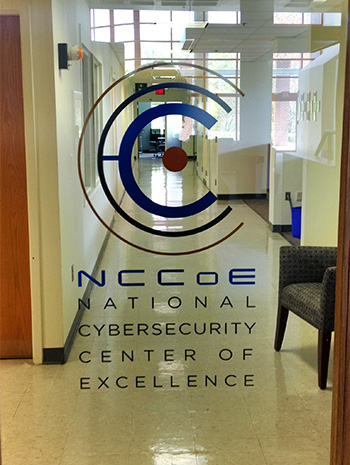
In launching a new veterans hiring effort within his state’s Ohio Means Jobs program, Gov. John Kasich wrote, "If a veteran wants to get a professional license, we’re changing state policies to make that easier. If you’ve taken care of soldiers on the battlefield, you should be able to take care of your neighbors at home. Or if you’ve driven a truck from Kabul to Kandahar, I think you’ve earned the right to drive a truck from Cleveland to Columbus." Veterans are expected to help the state in other career areas too. In April, a workforce study performed by Regionomics and sponsored by Insuring Ohio Futures found that the Ohio insurance industry was going to need 26,000 skilled workers by 2020, and that veterans would contribute substantially to plugging that workforce gap.
Where Opportunity Knox is Greater Louisville’s program to connect 10,000 veterans to jobs and the region by 2017. An initiative of the Kentucky Indiana Exchange (KIX) launched in June 2012, the program goes out of its way to define itself not as a jobs program, but as an initiative "about developing a pipeline of transitioning veterans who are looking for a post-military place to live and work – a place that values veterans, offers a high-level quality of life and has a diverse and robust economy with available jobs and careers."
Places to Land
USAA and Hiring Our Heroes commissioned Sperling’s BestPlaces to identify the best places in the nation for veterans to find employment whether they’re starting out, mid-career or retiring from the military.
Starting Out
- Pittsburgh
- Austin
- Oklahoma City
- San Antonio
- St. Louis
- Columbus
- State College, Pa.
- Cincinnati, Ohio
- College Station, Texas
- Minneapolis, Minn.
Mid-Career
- Houston
- San Antonio
- Santa Ana, Calif.
- Baltimore, Md.
- Austin, Texas
- Bethesda, Md.
- Cincinnati, Ohio
- New York, N.Y.
- Fort Worth, Texas
- Pittsburgh, Pa.
Retirement
- San Antonio
- Austin
- Madison
- Harrisburg, Pa.
- Cincinnati, Ohio
- Orlando, Fla.
- Wichita, Kan.
- Gainesville, Fla.
- Albany, N.Y.
- Nashville, Tenn.
Last month, South Carolina’s new Operation Palmetto Employment program recognized Savannah River Remediation, Verizon Wireless and CB&I as the state’s first Palmetto Military Employers (PME) for their ongoing commitment to hire and retain military employees. "This credentialing piece adds some teeth to our program, and provides the metrics and data needed to grow and sustain it," said Paul Prince, member of the OPE Credentialing Committee and the volunteer management director for S.C. Employer Support of the Guard and Reserve (SC ESGR). "We look forward to connecting with employers statewide who want to hire veterans and service members – not necessarily because they served, but because they bring a wealth of knowledge, leadership experience and highly transferrable technical skills to the civilian workforce."
"About 10 percent of our workforce, 196 veterans, are part of our team," said Mark Schmitz, deputy project manager at Savannah River Remediation. "I’m proud SRR has helped set the bar in hiring those who have faithfully and bravely protected our nation. We will continue to find ways to tap this important talent pool." Verizon Wireless has hired 112 service members this year alone in South Carolina, while CB&I currently employs over 900 service members and veterans at five different project sites statewide.
In September, everybody’s favorite upstart, ride-share service firm Uber, announced a partnership with Hiring Our Heroes to bring 50,000 veterans, service members and military spouses onto its platform as drivers in the next year and a half.
"By pledging to bring on 50,000 veterans and military spouses, Uber is telling them that this is not about charity – this is about finding the strongest candidates in the civilian workforce," said US. Chamber of Commerce President Thomas H. Donohue. "We look forward to working with Uber over the next 18 months to connect them with the best talent our country has to offer."
The pledge to hire 50,000 veterans will help Hiring Our Heroes move closer to its goal of securing jobs for 500,000 veterans by the end of 2014. Since March 2012, Hiring Our Heroes has worked to get pledges from businesses to hire a half-million workers under the Capital One Hiring 500,000 Heroes campaign. As of now, upwards of 1,700 companies have committed to hire more than 470,000 veterans and military spouses and 285,000 hires have been confirmed. Kim Morton, spokesperson for Hiring Our Heroes, says new numbers will be announced Nov. 12, and "we’re definitely planning to hit our mark."
Hiring Our Heroes (HOH) was launched by the US Chamber of Commerce Foundation in March 2011. Because of its success and commitment, Donahue last month was one of five individuals to receive from the US Army the Outstanding Civilian Service Award. Morton says HOH founded specifically because US Chamber member firms were looking for top-notch, dependable talent. A job fair in Chicago featured more than 100 companies and attracted more than 1,000 job seekers. Last week HOH held job fair No. 820. Morton says new numbers will be announced Nov. 12.
Morton offers these highlights from successful company veterans hiring programs:
- Ryder – Hired 1,495 in 2013, well above their commitment of 1,000. Raised the percentage of veterans in their workforce from 8 to 10 percent.
- Verizon – Hired 1,097 in 2013, above their commitment of 1,000.
- USAA – Hired 1,180 veterans and 652 military spouses (1,832), above their commitment of 1,500.
- Comcast-NBCUniversal – Hired 3,000 veterans since January 2012, far outpacing the company’s goal to hire 2,000 by 2015.
- PeopleScout – Placed 11,100 in jobs in 2012, above original goal of 10,000
- American Red Cross – Hired 1,013 veterans, above goal of 1,000 (Made commitment in July 2012 to make these hires by July 2014. Made them by June 2013.)
- Volt Workforce Solutions – Made 2,532 hires/placements over a goal of 2,000 in 2013
- Goodyear – A July 28 press release stated, "Two years ago, The Goodyear Tire & Rubber Company made a commitment to hire 1,000 United States military veterans. Today, the company announced that it surpassed its three-year goal more than a year early, and has pledged to hire an additional 1,000 veterans."
HOH has partnered with USAA to create an employer roadmap customized to a company’s specific needs when looking to hire veteran talent.
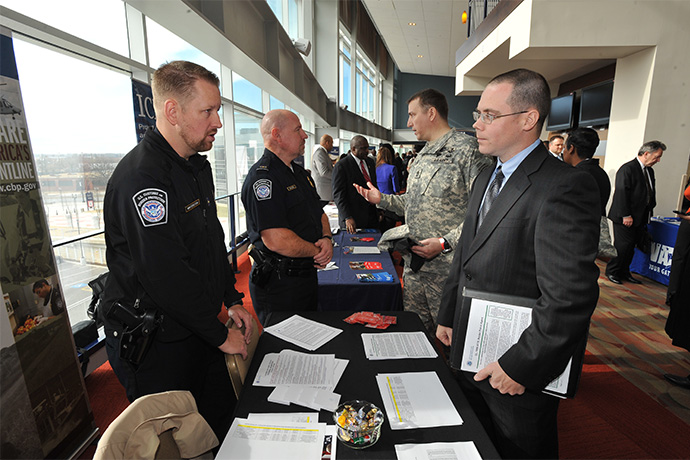
When it comes to working with employers, Morton says, "One thing we see time and time again is that once a company commits and starts building their initiative, either their momentum or excitement — or both — pushes them to the finish line early."
States Doing More
Among the Hiring Our Heroes programs is an attempt to marshal state-level resources via the All*Vet States program. But illustrating the challenge of coordination, only eight states have signed on so far, as of this week: Nebraska, Iowa, Illinois, Wisconsin, Michigan, Ohio, Tennessee and Maryland.
Gov. Terry Branstad’s Home Base Iowa initiative features Home Base Iowa Businesses pledging jobs specifically for veterans, and Home Base Iowa Communities developing incentive packages. Collectively, members of the Iowa Business Council have set a goal of hiring 2,500 veterans over the next five years. "The Iowa Business Council is proud to support such a noble cause," said Larry Zimpleman, chairman, president and CEO of Principal Financial Group, which recently invested $285 million in a reimagined corporate headquarters campus in Des Moines and employs 6,000 Iowans. "Our nation’s veterans have sacrificed so much for the advancement of our country. It is without question that we should give back and support these individuals and their families in every way possible."
Maryland recently held an event named "Operation Hire: Maryland’s 100 Day Veteran Hiring Challenge" in an effort to meet one of Gov. Martin O’Malley’s 16 strategic goals: full employment for Maryland veterans by 2015. Beginning June 1 and running through Sept. 9, the event attracted 184 participating state agencies, local jurisdictions and private-sector businesses from all over the state, including JP Morgan Chase and Lockheed Martin.
Dana Hendrickson, director, outreach and advocacy, for the Maryland Dept. of Veterans Affairs, says the event has led to well over 300 hires.
"We also created a veteran employer toolkit that will sit on our website permanently," says Hendrickson. "It combines resources that really speak to the employer, giving them a lot of information on not just veteran recruitment, but assimilating them into the civilian workplace. We received a lot of really positive feedback from employers and state agencies – some were not aware those resources were out there."
Central to the thought leadership of programs in Maryland and elsewhere has been the nationally focused Institute for Veterans and Military Families (IVMF), established by Syracuse University in June 2011. In its own words, the interdisciplinary institute "develops education and employment-focused programs in collaboration with industry, government, NGOs and the veteran community, to address the primary economic and public policy concerns of our nation’s servicemen and women, and their families."
Hendrickson hopes to see a veterans advisory council formed in the wake of Operation Hire, similar to a successful effort in neighboring Virginia, where, since launching in June 2012, the Virginia Values Veterans (V3) program has reached 650 companies, awarding them different levels of certification based on their hiring commitments. The companies have pledged a total of 8,066 jobs, and have reported a total of 6,525 hires. The program was specifically hailed by state leaders as an economic development initiative rather than a jobs program. Among the "Enterprise-level" companies certified in the V3 program is Booz Allen Hamilton, which has committed to 740 veteran hires.
It turns out theft of innovation is contagious and welcome when it comes to veterans hiring. A conversation Hendrickson had with an official in New Hampshire this summer has led to a copycat program, Operation VETS Connect, in the Granite State. The program launched Sept. 2 and ends Dec. 10.
In summing up the challenge of Operation Hire, Hendrickson sums up the challenge to each and every employer in the country:
"Essentially the challenge on its face is speaking to the business community and our state agencies to see what were they doing currently and, if they didn’t have a formal hiring initiative, seeing what they could put into place to develop one. It’s an opportunity to look at our ideology, and reframe the way we go about recruiting."
Got that?
Then mission accomplished.
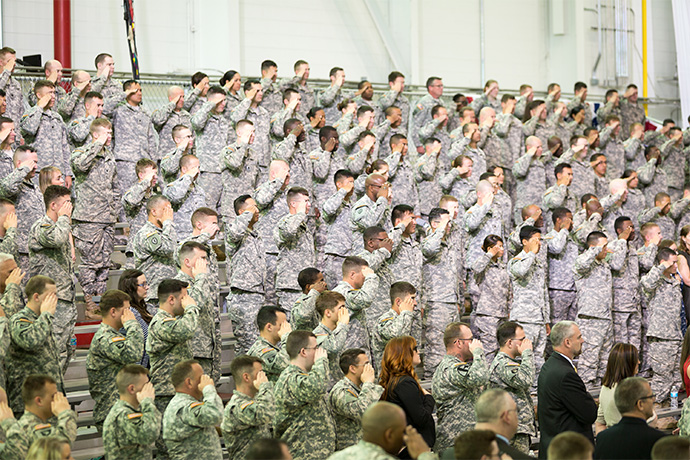
| Program | ||
|---|---|---|
| Alabama | Alabama Dept. of Veterans Affairs | |
| Alaska | Alaska Job Center Network "Hire a Veteran" | |
| Arizona | Arizona Dept. of Veterans’ Services | |
| Arkansas | Arkansas Veteran | |
| California | CalVet | |
| Colorado | Hire a Colorado Veteran | |
| Connecticut | Hire Vets First | |
| Delaware | Delaware Commission of Veterans Affairs | |
| Florida | Veterans Employment Program | |
| Georgia | Operation: Workforce | |
| Hawaii | State of Hawaii Workforce Development Division | |
| Idaho | Idaho Dept. of Labor Veterans Services | |
| Illinois | Illinois Hires Heroes Consortium | |
| Indiana | Indiana Dept. of Veterans’ Affairs | |
| Iowa | Home Base Iowa | |
| Kansas | Kansas Commission on Veterans’ Affairs | |
| Kentucky | Hiring Kentucky Heroes | |
| Louisiana | Louisiana Dept. of Veterans Affairs | |
| Maine | Maine CareerCenter | |
| Maryland | Maryland Dept. of Veterans Affairs | |
| Massachusetts | Executive Office of Labor and Workforce Development | |
| Michigan | Veterans Employment Services and "Shifting Heroes" | |
| Minnesota | Minnesota Dept. of Employment and Economic Development | |
| Mississippi | Hire Heroes | |
| Missouri | Show-Me Heroes | |
| Montana | Montana Dept. of Labor & Industry | |
| Nebraska | Nebraska Hires Veterans | |
| Nevada | Nevada Dept. of Employment, Training and Rehabilitation | |
| New Hampshire | New Hampshire Employment Security | |
| New Jersey | New Jersey Dept. of Military and Veterans Affairs | |
| New Mexico | New Mexico Dept. of Workforce Solutions | |
| New York | New York Dept. of Labor | |
| North Carolina | N.C. Division of Workforce Solutions | |
| North Dakota | Job Service North Dakota | |
| Ohio | Ohio Means Veteran Jobs | |
| Oklahoma | Oklahoma Employment Security Commission | |
| Oregon | WorkSource Oregon Employment Dept. | |
| Pennsylvania | Pennsylvania Dept. of Labor & Industrys | |
| Rhode Island | Rhode Island Dept. of Labor and Training | |
| South Carolina | Operation Palmetto Employment | |
| South Dakota | South Dakota Dept. of Labor and Regulation | |
| Tennessee | Tennessee Dept. of Veterans Affairs | |
| Texas | Just for Veterans | |
| Veteran and Industry Partnership (VIP) program | ||
| Utah | Utah Veteran Employment Services | |
| Vermont | Vermont Dept. of Labor | |
| Virginia | Virginia Values Veterans | |
| Washington | Dept. of Veterans Affairs | |
| West Virginia | WorkForce West Virginia | |
| Wisconsin | Wisconsin Dept. of Veterans Affairs | |
| Wyoming | Wyoming Dept. of Workforce Services |

